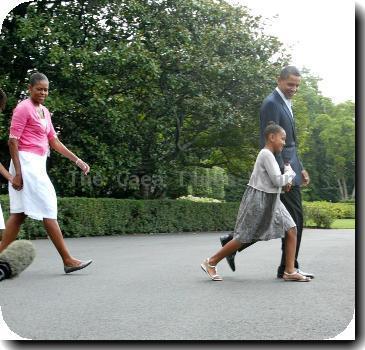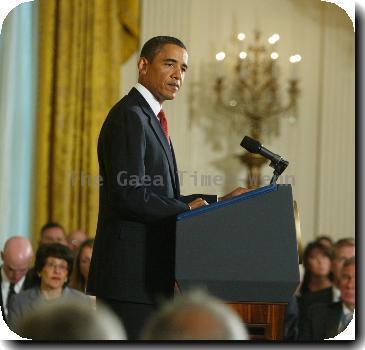Humanity gathers in ‘tribal barbecue’ under one roof, talking about the future of planet
By Charles J. Hanley, APFriday, December 11, 2009
Under one Danish roof, humanity talks climate
COPENHAGEN — Once every turn around the sun, inhabitants of our battered blue globe gather by the thousands in an assigned place, for a two-week ritual of despair and hope called a climate conference.
It’s humanity distilled under a single roof. And never has such a mix come together as in Copenhagen, where up to 34,000 people — from Eskimos to “talking trees” to CEOs — will have crowded through the Bella Center before it’s over next weekend.
In just 15 years, the annual conferences reviewing the 1992 U.N. climate treaty have grown into assemblies that, perhaps more than any other, encompass the human enterprise.
Where else will you find people talking about coal mines and cow diets alike, holding forth on reef fishing and nuclear fission, pushing micro-insurance and space satellites, seeking solutions in seaweed and solace in the spiritual side of “sustainability,” the dogma of the age?
The activist dressed as a polar bear, the protesters disguised as “trees,” the throngs in standard garb of faded jeans or sober suits in the noise and bustle of the Bella’s main atrium — all make up a sister-and-brotherhood that convenes yearly to commune, and often bicker, in the language of climate.
And when the bells of churches ring out 350 times this Sunday across Denmark, the brothers and sisters will know what the bells are tolling for: Many environmentalists say carbon dioxide must be reduced to 350 parts per million in the atmosphere.
The conference’s job is to build on the climate treaty, to find ways to reduce our civilization’s emissions of CO2 and other gases that come from burning fossil fuels, destroying forests, raising cattle, making cement, growing rice and many other activities that feed us, warm us, transport and enrich us.
If we don’t cut back, the global-warming gases enveloping the planet, most scientists agree, will transform its climate, its land and its oceans into something very different from what man has relied on for ages.
That reliance runs thick in our blood, whether it’s an Arctic native hunting seal on the ice, a farmer sowing wheat in Australia, an insurance actuary calculating risk in Zurich, or a homeowner flipping on lights powered by hydroelectric dams in the American West.
The interests of all those people and many, many more converge each year for the “COP,” the treaty’s Conference of Parties.
“The complexity of the talks has increased exponentially. You name it, it has been thrown into the climate change pot,” said Cambridge University’s Joanna DePledge, who as a U.N. expert helped write the 1997 Kyoto Protocol reducing industrialized nations’ emissions, the conferences’ major achievement so far.
The pot boils every day under the sloping glass roof of the Bella’s atrium, a broad space hundreds of yards long where environmental, business and other advocacy groups assemble for early-morning huddles around white plastic tables, amid chirping cell phones and tangles of laptop wires, to plot the day’s intelligence and lobbying missions.
Thousands of delegates from 192 nations then file into meeting rooms spread around the vast halls, cheerless places named for great Danes (Hans Christian Andersen, Karen Blixen and Victor Borge, of course). There, behind closed doors, they debate and mark up texts on the issues before them — “greenhouse gas inventories,” ”clean development mechanism,” ”transfer of technologies.”
The aim is to whittle down overloaded papers and make them manageable for approval in next week’s final days, when President Barack Obama and more than 100 other national leaders arrive.
The hush and protocol of the meeting rooms is sometimes broken by sudden protests in the open halls and corridors outside, when young environmentalists among the conference participants put down their clipboards and pick up signboards.
After the tiny Pacific island state of Tuvalu, doomed by global warming’s rising waters, was gaveled down in a bid to force more drastic action on climate, hundreds of activists descended on the doorway to the main conference hall, chanting “Tuvalu! Tuvalu!” as U.S. and other delegates passed. Five protesters posing as a mobster hit squad in outlandish red suits, brandished signs advising delegates, “Rich countries, pay your carbon debt.”
“This is my first COP,” marveled Pacific islander Linda Oan, a Kiribati delegate. “It’s really something.”
But mostly it’s a steady thrum of work that prevails, including lobbying by groups from Greenpeace to the Federation of Electric Power Companies. Those organizations stage “side events” to educate delegates, journalists and each other, and ply delegations with smiles, data and lawyers’ suggestions for new treaty language.
Raul Estrada-Oyuela, a retired Argentinian diplomat considered the “father” of the Kyoto Protocol, grew to appreciate the input of these non-governmental organizations through years of hard conference bargaining.
“More than once I discovered they have better ideas than the bureaucracy,” he said.
In the end, the Copenhagen debate will look from afar to have been a simple contest of rich versus poor, of north against south. But the outcome, likely an interim deal to be concluded at the next assigned place, Mexico City in 2010, will truly be the messy creation of a worldful of causes come together for two weeks in Denmark.
It’s a “tribal barbecue,” said another veteran, Peter Goldmark of the U.S. Environmental Defense Fund.
“We’re talking about which businesses will grow, which investments will make sense, how we’ll feed ourselves, what kind of energy we’ll produce,” he said. “This is the work of years and decades.”
Tags: Animals, Australia And Oceania, Barack Obama, Copenhagen, Denmark, Environmental Activism, Europe, International Agreements, Mammals, North America, Tuvalu, United States, Western Europe

